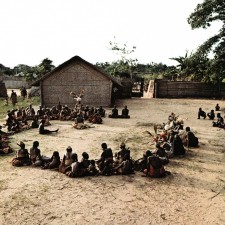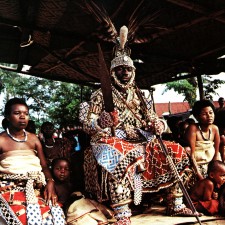The Kuba, also known as Bakuba, were a cluster of about 16 Bantu speaking groups. They lived in Southeastern Congo. The Kuba kingdom was largely isolated due to its geographical location. As a result, the kingdom almost got no effect from slave trade.
It is on record that this trade was prevailing in all other kingdoms in Africa. Slave trade even affected the kingdoms of Kongo and Ndongo. These kingdoms were neighboring Bakuba.

Source: theafricanhistory.com
Where is the Kuba Kingdom located?
The Kuba kingdom was located between the Kasai and Sankuru rivers. Particularly, in the east of their confluence. The kingdom also neighbors the Lulua River. All these rivers are in the southern region of the Democratic Republic of Congo (Congo-Kinshasa).

Source: en.wikipedia.com
To be in this location, the Kuba migrated from the far north. This kingdom emerged in the 1600s. It was one of the most powerful kingdoms that flourished from the 17th to the 20th centuries.
What was the main religion in the Kuba Kingdom?
Religiously, nature spirits, the spirits of dead kings and witch craft dominated the Kuba religion. The Kuba also believed in Bumba. This is the sky father who sent out the sun, moon, stars, and planets. Bumba also created life with the earth mother.
The Kuba also placed more concern in a supernatural being named Woot. Woot named the animals and other things. However, these were distant deities.
Origin of the Kuba Kingdom
In 1625, a great man from outside the area surfaced. This great man was known as Shyaam a-Mbul Ngoong. He took the position of one of the area rulers. In so doing, he united all the chiefdoms under his leadership. Shyaam a-Mbul was the adopted son of the Kuba queen.
He left Kuba region to find enlightenment in the Pende and Kongo kingdoms. These were in the west of Kuba land. Shyaam a-Mbul thereafter returned to Kuba from learning all he could in these states. He started to form the empire’s political, social and economic foundations.
The Kuba government under Shyaam a-Mbul was reorganized towards a merit-based title system. However, power was still firmly in the hands of the aristocracy.
Leadership and social life among the Kuba/Bakuba
The kingdom was a federation of chiefdoms. Each chiefdom was under a chief, and two or three councils. These councils represented the general population and noble clans.
The Kuba were divided into lineages related through matrilineal descent. The lineages were segments of numerous dispersed clans.
Therefore, the kingdom was a conglomerate of several smaller Bushongo-speaking principalities. Later on, the Kete, Coofa, Mbeengi, and the Kasai Twa Pygmies came under the kingdom.

Source: theAfricanhistory.com
Since the 16th century, the kingdom was under various Bushoong or Bushongo clan kings. The ruling Bushoong King (nyim) was King by divine right. This king was responsible to a court council of all the Kuba sub groups. The elites of the subgroups represented them equally before the king.
King Kot Mabiinc.
Among these Kuba kings, however, stood out Kot Mabiinc. This was the paralyzed king who ruled from 1919 to 1939.

Source: facetofaceAfrica.com
According to an African-American researcher William Sheppard, King Mabiinc suffered from polio. He was also overweight. The king used a wheelchair to serve as a throne. This was provided by the American Presbyterian Congo Mission (APCM).
Mabiinc later professed his Christian faith. Such an act inspired a number of prominent Kuba men and women to do the same. However, this happened at a time when many others believed in supernatural powers. These included spells and witchcraft.
Kot Mabiinc and the changes in Kuba culture.
The king also made another distinguished change in the Kuba culture. He abolished the practice of burying a deceased king’s servants alongside him.
In the Kuba culture initially, when a king died, it meant cutting off of the hands and legs of his servants. These were to serve as a cushion for the coffin. Kot Mabiinc indicated that sticks of camwood should be used instead.
During his reign, the Kuba kingdom included other tribes. These were the Ngeendes, Ngongos, Shoowas, Bieengs, and Ngombes.
The uniting factors of these tribes included; bonds of common culture and group feeling. Others are; a royal army and a common administration. These tribes under the Kuba kingdom emerged as one of Africa’s artistic peoples.
How did Kot Mabiinc develop the Kuba Kingdom?
During Mabiinc’s time, Kuba became extremely wealthy. This came as a result of great artistic works by the different tribes in the kingdom. These works were commissioned by the Kuba nobility. This happened as early as the 1900s.
The Kuba kings retained the most fanciful works for court ceremony. Kings were also buried with these artifacts. The kingdom also benefited from the advanced techniques from the neighboring people.
The Kuba Kingdom and the Europeans
The New World crops grown in the kingdom also contributed to its development. These were introduced by the Americans. They included; cassava, corn (maize), tobacco, and beans. Others are; millet and peanuts (groundnuts).
As German historian Leo Frobenius put it: “In 1906, when I penetrated the Kasai-Sankuru territory, I found again villages. The main streets of these villages were enclosed on each side with four rows. There were decorated huts, each in a charming way. These were artworks as well.
Every man wore iron or copper weapons, blade inlaid with the handle covered with snake skin. Each cup, each pipe, each spoon was an art object. These objects were perfectly worthy to be compared to the European Roman style creations…..”

Source: Africa.Uima.Uiowa.Edu
The Kuba Kingdom in modern days.
Kuba has evolved into Africa’s most artistic and technological indigenous cloth makers. They are known for their beautiful textiles. These are made from vegetal fibers, raffia, bark, and palm tree leaves.

Source: christiandoux.Com
The Kuba grow raffia, oil palms and raise corn as a cash crop. Men also hunt and fish. They have kept away from modern life. By doing this, few have emigrated or engaged in European occupations.
In the Kuba culture, men make plain cloths. Women have continued to use hand-stitched embroidery or cut pile techniques. They use them to enhance plain-cloths that were traditionally woven by men.

Source: theAfricanhistory.com
Other artistic works in the Kuba kingdom.
In addition to beautifully embroidered hand woven cloth, the Kuba make carved wooden initiation masks. They make figurines and carved palm wine cups. Bakuba also make headrests and divination or prophecy oracles.

Source: facetofaceAfrica.com
Other items include monumental helmet masks featuring exquisite geometric patterns. There are spectacular fabrics, seeds, beads and shells. The Kuba also make fiber and beaded hats plus cosmetic boxes as well.

Source: the Africanhistory.com
Artworks for trade in the Kuba Kingdom.
The unique items in the Kuba kingdom are frequently traded to neighboring areas. They are therefore priced for export. The carved palm wine drinking cups and ornately carved boxes are identified with competitions. These are between titled court members among the Kuba.
The western collectors highly demand for the royal Kuba textiles and artifacts. This is due to scarcity of such items in the west.

Source: christiandoux.Com
The items from Kuba artwork are also featured in permanent exhibition halls at major art museums. These are in New York, London, Paris, and Brussels.
